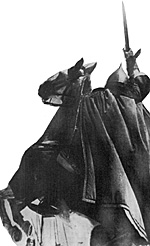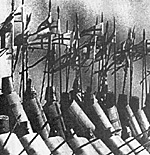 THE HARE AND THE VIXEN: A RUSSIAN FAIRY TALE
THE HARE AND THE VIXEN: A RUSSIAN FAIRY TALE
So the hare hopped into a ravine and so did the vixen, the hare ran to a copse, and the vixen followed him. Then the hare made for a slit between two birch-trees. The vixen ran after him and got stuck.
She got stuck good and well and no matter how she tried to free herself, she couldn't.
The hare came up from behind and grimly said, 'Better say bye-bye to your maidenhood.'
'Don't neighbour, please don't. I'll die of shame. Have pity!'
'I've no time for pity, the hare replied. And he promptly did what he had threatened.
HISTORICAL BACKDROP
The famous battle between Alexander Nevsky and the Teutonic Knights happened on Lake Peipus in 1242, in the backwash of the Mongol invasion of eastern Europe. After the Mongols vanquished the Volga Bulgars, they turned their attention to the principalities of Rus. The first city to feel their wrath was Vladimir. The Mongol general Subudei's grand strategic plan called for a major offensive through southern Rus, including Vladimir and Kiev, before the Mongols toppled Galicia, Poland, Hungary and then the rich interior of Europe. Subudei established a demanding timetable that capitalized upon the Mongol's superior mobility to achieve his goals. Minor operations to the north were allowed as long as they did not interfere with his schedule.
In February 1238, the Mongols razed Vladimir and killed the entire ruling family except Grand Duke Yuri. Subudei pursued Yuri to the north while Batu, the other Mongol commander, led a detachment against Novgorod in the northwest. An early spring thaw turned the surrounding countryside into a vast marsh, curtailing Mongol progress. In addition, Batu besieged the city of Torzhok for two weeks, and this pause eliminated any chance of surprise against Novgorod. Batu halted 60 miles short of Novgorod. He reversed direction and rejoined Subudei.
When the Mongols rendezvoued, Subudei chose to regroup in the Don River basin before launching the next major offensive. These events enabled Novgorod to be spared. The Mongols calculated that Novgorod was militarily weak and not worth the military effort needed to subdue her. She would be a cooperative pawn in the Mongol rear while major conquests took place in central Europe. Subsequent events confirmed the accuracy of this prediction.
Other powers sought to exploit the power vacuum created by the Mongol's path of destruction. Sweden under Earl Birger attempted to gain territory at Novgorod's expense, but Prince Alexander defeated the Swedes at the Neva River in 1240. This exploit earned Alexander his sobriquet "Nevsky". Novgorod's most ominous threat, however, came from the west.
THE TEUTONIC ORDER
 The Order of Teutonic Knights of St. Mary's Hospital in Jerusalem was founded in 1198. The Order's principle sphere of activity developed outside of the Outremer. After a brief tour in Hungary, the Order moved to east Prussia and Lithuania as vassal to the Pope and the Emperor. By 1237, it had absorbed the Sword Brethren of Livonia and continued the latter's policy of eastward expansion. Roman Catholicism was carried to the pagan Prussian and Lithuanian tribes in
the vicinity by the sword. The Sword Brethren had already captured the Novgorodian city of Yuriev and renamed it Dorpat. By 1240, the Order was ready to bring their Faith and carve out further estates for itself at the expense of the schismatic Rus of Pskov and Novgorod.
The Order of Teutonic Knights of St. Mary's Hospital in Jerusalem was founded in 1198. The Order's principle sphere of activity developed outside of the Outremer. After a brief tour in Hungary, the Order moved to east Prussia and Lithuania as vassal to the Pope and the Emperor. By 1237, it had absorbed the Sword Brethren of Livonia and continued the latter's policy of eastward expansion. Roman Catholicism was carried to the pagan Prussian and Lithuanian tribes in
the vicinity by the sword. The Sword Brethren had already captured the Novgorodian city of Yuriev and renamed it Dorpat. By 1240, the Order was ready to bring their Faith and carve out further estates for itself at the expense of the schismatic Rus of Pskov and Novgorod.
The Teutonic Order's military complement consisted of Brother Knights and Sergeants drawn from its own estates. In addition, other German knights joined the expedition as crusaders. The infantry included "Halbbruder" or Novices, Danish mercenaries, and Lithuanian tribesmen seeking to regain lost territory. The Order's usual combined arms ratio was one Knight to four Brethren, to as many foot soldiers as the particular endeavour required. Evidence for this battle indicates a force of approximately 5,000 men, with most of the Brethren and some Knights fighting dismounted.
NOVGOROD'S ARMED FORCES
As mentioned previously, Novgorod's army was commanded by Alexander Nevsky. Novgorod was a constitutional republic, where Nevsky's princely rank was limited by law to being responsible for leading the army in wartime. After Nevsky had defeated the Swedes, he had argued with Novgorod's nobility and merchants over various political issues. He exiled himself to the Mongoloccupied south around Periaslavl. When the Teutonic knights captured Pskov, Novgorod's junior sister city, he returned to resume his duties as military commander.
The armies that characterized the principalities of Rus in the thirteenth century contained three essential elements: the Druzhina, the Polk and mercenaries. The Druzhina included the mounted retainers of various sovereigns or important nobles and formed a military elite. The Polk was the city militia and was summoned by the city councils during emergencies. It included every able-bodied freeman, encompassing even the free peasantry (Smerdy) from the adjoining countryside. The peasantry usually carried out non-combatant tasks, but it was used in a combat role for this battle. Mercenaries were not mentioned in the sources for this battle. Quite probably, the Mongols incorporated whatever Cuman or Pecheneg mercenaries that existed into their own army. These asiatic light cavalrymen, however, more generally served with the southern principalities rather than Novgorod.
More Ice Slaughter
Back to Table of Contents -- Courier Vol. IV #1
To Courier List of Issues
To MagWeb Master Magazine List
© Copyright 1982 by The Courier Publishing Company.
This article appears in MagWeb (Magazine Web) on the Internet World Wide Web.
Other military history articles and gaming articles are available at http://www.magweb.com